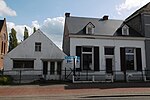Begijnendijk
Flemish Brabant geography stubsMunicipalities of Flemish BrabantPages including recorded pronunciationsPages with Dutch IPA

Begijnendijk (Dutch pronunciation: [bəˈɣɛi̯nə(n)ˌdɛi̯k] ) is a municipality located in the Belgian province of Flemish Brabant. The municipality comprises the towns of Begijnendijk proper and Betekom. On January 1, 2006, Begijnendijk had a total population of 9,400. The total area is 17.62 km² which gives a population density of 534 inhabitants per km². The official spoken language is Dutch. On the 25th of July 2019, the hottest ever recorded in Belgium was recorded in Begijnendijk, the town recording a temperature of 41.8 °C (107.2 °F), beating the temperature of 40.2 °C (104.4 °F) recorded in Angleur, recorded just the previous day.
Excerpt from the Wikipedia article Begijnendijk (License: CC BY-SA 3.0, Authors, Images).Begijnendijk
Vissendijk,
Geographical coordinates (GPS) Address Nearby Places Show on map
Geographical coordinates (GPS)
| Latitude | Longitude |
|---|---|
| N 51.016666666667 ° | E 4.7833333333333 ° |
Address
Vissendijk 6
3130 (Begijnendijk)
Flemish Brabant, Belgium
Open on Google Maps









